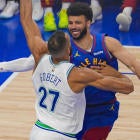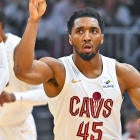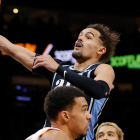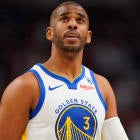NEW YORK -- Unthinkable as it may be, Stephen Curry found himself slumping. In the first three games of an arduous road trip, he missed 27 of 31 3-point attempts. In the second game, fellow Golden State Warriors superstar Kevin Durant sprained his MCL, leading to two straight losses -- a relative catastrophe in Warriors world -- and putting more pressure on Curry to get back on track.
At practice on Saturday, Curry said he just had to fight through the cold spell and not let it affect him. Maybe the team as a whole needed some more ball movement early in games, he said, but it would be OK. Then he missed his first four 3s against the New York Knicks on Sunday, including a wide-open look in the corner.
How does the best shooter of all-time regain his rhythm? Does he think about all the seemingly impossible shots he has made, all his huge scoring nights and clutch performances? Does he go through a 20-point mental checklist like Kyle Korver, analyzing every little detail of his form? No.
“I don’t ever lose confidence,” Curry said after Golden State’s 112-105 win on ABC. “My assistant coach Q [Bruce Weber] was telling me to think about nothing. Which I was trying to do -- like, don’t worry about mechanics, don’t worry about what’s gone on the last two or three games. Just shoot.”
Weber wasn’t the only coach to give him a pep talk. The broadcast also showed Steve Kerr, stat sheet in hand, talking to Curry about his plus-minus and how his misses don’t mean he’s playing poorly.
“He was a plus-15 and I think he was like 3-for-11 at the time,” Kerr said. “I know as a shooter sometimes you base everything on whether your shot’s going in, but I just felt like he was giving us a huge boost with his energy and just pushing the ball in transition and putting a lot of pressure on the defense. So I just wanted to remind him that shots may go, they may not, but you’re still having a huge impact on this game.
“I feel that way pretty much every game with Steph. He kind of tilts the floor, the defense has to react to him and it helps everybody.”
The message from both of them was that Curry needn’t worry about the “problem” with his shooting. To fix it, he had to not see it as a problem at all. If this all sounds Zen, perhaps it’s appropriate. After Curry caught fire in the third quarter and led his team to a victory, Kerr chatted with Phil Jackson outside the visiting locker room at Madison Square Garden.
Curry’s strange little lull made headlines, but it didn’t have broader significance. Opponents don’t change their game plans against Curry when he misses a few shots, and he doesn’t start doubting himself or hesitating. Kerr is correct in saying that he doesn’t have to hit shots to help his team -- his mere presence and reputation makes the game easier for his teammates because defenders are terrified of letting him get going.
The bigger question about Curry is why his numbers aren’t quite the same as they were. Last season, he averaged 30.1 points on 50.4 percent shooting, making 45.4 percent of his 3s and shattering the NBA record with 402 3-pointers made. In January, Kerr compared that year to Ted Williams hitting .406, adding that Curry was in a “no-win situation” because he had to live up to one of the best individual seasons ever.
At first, there were legitimate concerns about how he was fitting in with Durant. Curry wasn’t scoring 30-plus points or launching from 30-plus feet as often as usual, instead deferring in order to make his new teammate comfortable. After a couple of months, Durant directly told Curry to just play his game. In the 2017 calendar year, he’s averaged 26.1 points on 19.9 shots with a 29.8 percent usage rate, per NBA.com. He has been more aggressive than he was in his first MVP season, but not quite as efficient as he was in his second.
“It hasn’t been a big adjustment at all,” Warriors forward Draymond Green said. “They mesh great. I think early on in the year he was kind of trying to figure out a balance of what he should do and what he shouldn’t do, and then he realized all he had to do is be him. And that’s what he’s been doing.”
Kerr credited Curry for learning how to manage the game better and spread the ball around. Curry acknowledged that there has been a change, but described his approach as consistent.
“It’s a different situation, obviously, with the rotation that we have, and adding K.D.,” Curry said. “How high the bar is set from the last two years, I want to continue to get better. And it may look a different way to the eye as I play, but the impact that I try to have every night remains the same. I try to make my teammates better, shoot the ball at a high level, be ready for big moments and just do my part and push. Bring the energy every night and hopefully everybody follows suit.”

There is an idea that, with Durant out, Curry will have an opportunity to go back to his old self and dominate games as routinely as he did when Golden State marched to an NBA record 73 regular-season wins. Kerr knows the team feeds off of Curry when he plays with absolute freedom and launches off-the-dribble 3s, but rejects the notion that he has to alter anything.
“I don’t think it was holding him back when K.D. was here,” Kerr said. “I think he’s been super aggressive, especially the last couple of months. Without Kevin, I think Steph and Klay [Thompson] know they’re going to get probably even more shots. The biggest thing is we’ve gotta get great shots.”
Curry said the Warriors “don’t change the way we play, but with K.D. out there’s more of an emphasis on especially me and Klay, Andre [Iguodala], Shaun [Livingston] to look to score and push the envelope a little bit.” He is aware that Durant won’t be around to bail out bad possessions, but that doesn’t mean he’s going to try to do things himself. Golden State probably isn’t suddenly going to lead the league in pick-and-rolls, either. The goal, as always, is for movement on offense to generate open looks.
When healthy, Durant used possessions that could have gone to Curry, and the absence of a 7-footer who can score from anywhere on the court will change the way the Warriors function. Curry still has to play instinctively, though, and his challenges -- using opponents’ pressure against them, finding seams in defenses designed to stop him, limiting turnovers -- remain the same.
“When the game says shoot, you shoot,” Green said. “[Curry] understands that. I don’t know, maybe there will be more pick-and-rolls with us, maybe not. You just figure out the flow of the game and you adjust to it.”
Curry knows the attention will be there no matter what. First, it was about how he’d play with Durant; now, it’s about how he’ll play without him. There is pressure to hold off the San Antonio Spurs and keep the top seed in the Western Conference, and there is less room for error without Durant. There might even be a window here for Curry to remind everybody that, at his peak, he can still be the best player in the league.
He knows all of this, but he also knows he can’t dwell on any of it. Curry is a rhythm player on a team that is at its best when its offense is flowing. After the past couple of seasons, he is used to the spotlight, the overreactions and the endless questions. The way to handle it is the same way he broke out of his slump: Don’t think, just shoot.






















